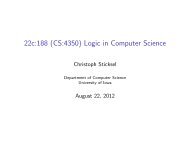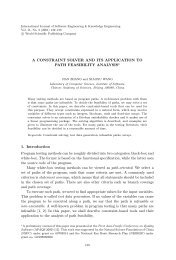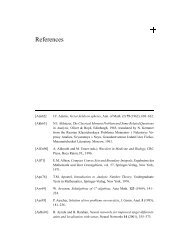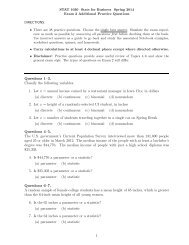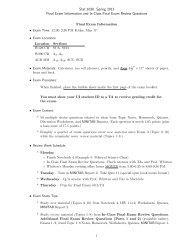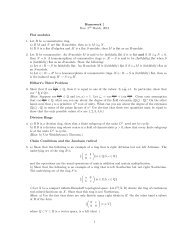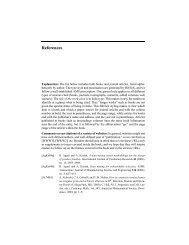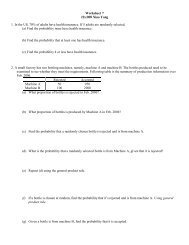22C:16 Exam 2
22C:16 Exam 2
22C:16 Exam 2
- No tags were found...
Create successful ePaper yourself
Turn your PDF publications into a flip-book with our unique Google optimized e-Paper software.
<strong>22C</strong>:<strong>16</strong> <strong>Exam</strong> 2<br />
April 1st, 9:30-10:20<br />
This is an open notes exam. You have 50 minutes to complete it.<br />
1. [40 points] For each of the following expressions, assume that<br />
L = ["hello", "good day", "hi", "see you", "ciao", "au revoir"].<br />
(a) L.extend(L[1].split())<br />
What is the value of L after the execution of this expression<br />
(b) map(len, L[2::2])<br />
What value does this expression evaluate to<br />
(c) L[3].split()[1][2]<br />
What value does this expression evaluate to<br />
(d) map(range, map(len, L)[2:5])<br />
What value does this expression evaluate to<br />
(e) del L[::3]<br />
What is the value of L after the execution of this expression<br />
1
(f) L in (L + [L])<br />
What value does this expression evaluate to<br />
(g) L[2] = L[2] + " " + L[1]<br />
What is the value of L after the execution of this assignment<br />
(h) L.insert(L.index("ciao"), "Tschuess")<br />
What is the value of L after the execution of this expression<br />
(i) (L*3)[3:9]<br />
What value does this expression evaluate to<br />
(j) L.insert(0, L.pop())<br />
What is the value of L after the execution of this expression<br />
2
2. [35 points] Consider the following program<br />
def foo(x):<br />
global z<br />
z = 20<br />
return x + y - z<br />
x = 12<br />
y = 15<br />
z = 11<br />
y = foo(8)<br />
print x + y - z<br />
(a) What is the output of this program when it is executed<br />
(b) Now delete the global z statement from the function foo. What is the output of<br />
this modified program when it is executed<br />
(c) Now start with the original program and replace the function header by a new header:<br />
def foo(x=10, y=20):<br />
What is the output of this modified program when it is executed<br />
(d) Now start with the program as modified in part (c) and replace the line containing the<br />
function call (i.e., the second last line) by y = foo(y, foo()) What is the output of<br />
this modified program when it is executed<br />
3
3. [35 points] There is a popular word puzzle in which you are given two words and you are<br />
asked to transform the first word into the second via a sequence of words, each obtained by<br />
substituting exactly one letter in the previous word. Of course, you have to make sure that<br />
all the intermediate words are valid words in the English language. For example, given the<br />
words “salt” and “bond,” the following would be a solution to the puzzle: “salt” “sale”<br />
“bale” “bane” “band” “bond.”<br />
Your task is to write a program that reads a sequence of words that is supposedly a solution<br />
to this puzzle and determines if the sequence is a valid solution or not. For example, if the<br />
input is<br />
salt sale bale bane band bond<br />
your program should respond with a message such as Valid word sequence!, whereas, if<br />
the input was<br />
text test bent bend bond<br />
your program should respond with a message Not valid. Try again! Note that in this<br />
example, going from test to bent required substituting two letters. Another reason a<br />
word sequence may be invalid is that it may contain one or more words that are not valid<br />
English words.<br />
(a) To complete this program, let us first write a function notNeighbors that takes two<br />
words word1 and word2 as parameters and returns True if word2 cannot be obtained<br />
from word1 by substituting exactly one letter by another and returns False otherwise.<br />
My plan is to count the number of corresponding letters in the two words that are<br />
not identical. If this count is not equal to 1 then the two words are not “neighbors”<br />
and the function should return True. The code given below is missing some lines and<br />
your task is to supply the missing code and complete the function.<br />
def notNeighbors(word1, word2):<br />
if len(word1) != len(word2):<br />
return True<br />
count = 0<br />
# Three lines of missing code for scanning the two words<br />
# and comparing corresponding letters goes here.<br />
if count != 1:<br />
return True<br />
else:<br />
return False<br />
4
(b) Here is a partial attempt at writing the main program. The program contains code (in<br />
the first two lines) for reading in the “dictionary” from the file “dictionary.txt” and<br />
for reading in the user input. You can assume that loadDictionary and getInput<br />
are appropriately defined functions and so you do not have to bother with defining<br />
these. After the first two lines of code are executed, the variable dictionary contains<br />
a list of valid English words and the variable L contains, as a list, the sequence of<br />
words input by the user. The program is missing some important code for scanning<br />
the sequence of words in L and determining if these words are valid English words<br />
and if they form a valid sequence. Your task is to supply this missing code.<br />
# reads words from the file into a list called dictionary<br />
dictionary = loadDictionary("dictionary.txt")<br />
# reads input provided by the user<br />
L = getInput()<br />
# bool variable that tracks if the word sequence is valid<br />
valid = True<br />
# Missing lines of code should go here.<br />
if valid:<br />
print "Valid word sequence!"<br />
5
4. [40 points] You are given a list L or arbitrary length, but guaranteed to contain only<br />
numbers from the set {1, 2, . . . , 10}, in some order. Your task is to write an efficient<br />
function to sort the list L taking advantage of the fact that L in known to contain only<br />
these numbers.<br />
Here I describe a simple algorithm called counting sort to do this:<br />
Step 1 Count the number of times 1 occurs in L, 2 occurs in L, etc. Store these counts in<br />
a size-10 list, called countList.<br />
Step 2 Produce a new list that first contains as many 1’s as specified by countList,<br />
followed by as many 2’s as specified, by countList, and so on. The function should<br />
return this newly constructed list.<br />
Notes: (i) Use the following function header: def countingSort(L):<br />
(ii) The function is fairly short: I wrote Step 1 in 3 lines of code, Step 2 in 3 lines of code,<br />
with one extra line to return the new list from the function.<br />
6



